Related Research Articles

David Rizzio, sometimes written as David Riccio, was an Italian courtier, born close to Turin, a descendant of an ancient and noble family still living in Piedmont, the Riccio Counts di San Paolo e Solbrito, who rose to become the private secretary of Mary, Queen of Scots. Mary's husband, Lord Darnley, is said to have been jealous of their friendship because of rumours that Rizzio had impregnated Mary, and he joined in a conspiracy of Protestant nobles to murder him, led by Patrick Ruthven, 3rd Lord Ruthven. Mary was having dinner with Rizzio and a few ladies-in-waiting when Darnley joined them, accused his wife of adultery and then had a group murder Rizzio, who was hiding behind Mary. Mary was held at gunpoint and Rizzio was stabbed numerous times. His body took 57 dagger wounds. The murder was the catalyst of the downfall of Darnley, and had serious consequences for Mary's subsequent reign.

Polidoro Caldara, usually known as Polidoro da Caravaggio was an Italian painter of the Mannerist period, "arguably the most gifted and certainly the least conventional of Raphael's pupils", who was best known for his now-vanished paintings on the facades of Roman houses. He was unrelated to the later painter Michelangelo Merisi da Caravaggio, usually known just as Caravaggio, but both came from the town of Caravaggio.
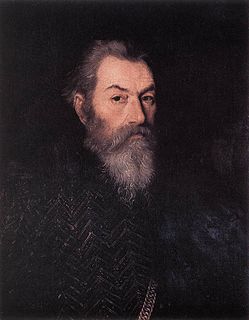
Paolo Farinati was an Italian painter of the Mannerist style, active in mainly in his native Verona, but also in Mantua and Venice.
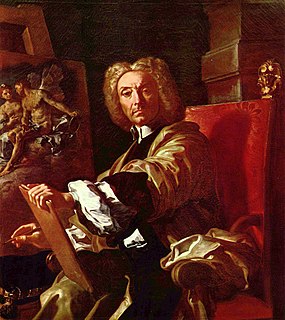
Francesco Solimena was a prolific Italian painter of the Baroque era, one of an established family of painters and draughtsmen.
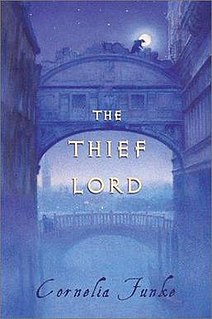
The Thief Lord is a children's novel written by Cornelia Funke. It was published in Germany in 2000 and translated into English by Oliver Latsch in 2002 for The Chicken House, a division of Scholastic publishing company. It was also adapted into a film in 2006.
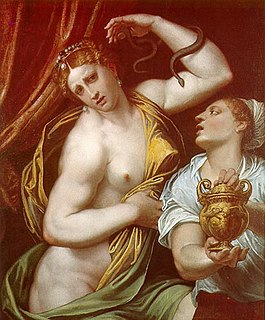
Domenico Riccio was an Italian painter in a Mannerist style from Verona, best known for frescos.

Bernardino India (1528–1590) was an Italian painter of the late Renaissance, born and mainly active in Verona. He is said to have trained with Domenico Riccio. He collaborated with Michele Sanmicheli in the Canossa palace and Pellegrini chapel in San Bernardino of Verona. He collaborated with Felice Brusasorci, Domenico's son in frescoes at Palazzo Fiorio Della Seta. He decorated Palladian villas such as Villa Pojana, Villa Foscari where Giovanni Battista Zelotti also worked, and the Palazzo Thiene in Vicenza. Orlando Flacco completed his most extensive work for the Sala Maggior di Consiglio in Verona.
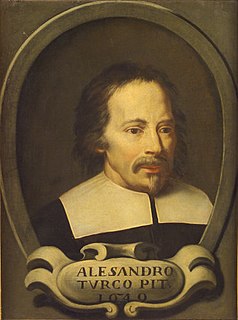
Alessandro Turchi was an Italian painter of the early Baroque, born and active mainly in Verona, and moving late in life to Rome. He also went by the name Alessandro Veronese or the nickname L'Orbetto. His style has been described as soft and Caravaggesque at the same time.

Felice Riccio (1542–1605) was an Italian painter of the late-Renaissance period, born and mainly active in Verona. He is also known as il Brusasorci or Brusasorzi or Felice Brusasorci. He was the son of the painter Domenico Riccio. He painted a Deposition for the church of Tombazosana in the town of Ronco all'Adige. He painted a canvas for the Sanctuary-Basilica of Santa Maria della Pace in Verona.

Guido I da Polenta was lord of Ravenna from 1275 until his abdication in 1297.
Giovanni Battista Buonocore was an Italian painter of the Baroque period. He became Rector (1679), then Principe (1698) of the Accademia di San Luca of Rome.
Francesco Antonio Coratoli was an Italian painter of the late-Baroque or Rococo periods.
Gaetano Martoriello was an Italian painter of the late-Baroque period, active in his natal city of Naples. He painted mainly marine vedute and landscapes. He initially trained under Giacomo del Po, but desiring to paint landscapes he worked under Nicola Massaro, who claimed to have trained under Salvatore Rosa. He is also said to have worked under Francesco Solimena, after the later painter rebuked Martoriello for criticizing some paintings by the German landscape artist, Francesco Joachim Beich.

Andrea Malinconico was an Italian painter of the Renaissance period, active near his natal city of Naples. He was a pupil of Massimo Stanzione.

Marzio Masturzo was an Italian painter of the Baroque period, active near his natal city of Naples. He was a pupil of Paolo Greco, then, along with Salvatore Rosa, a fellow-pupil of Aniello Falcone. Like Falcone, he often painted battle scenes. He appears to have joined during the Masaniello revolt, a loose fraternity of artists called the Compagnia della morte involved in the rebellion.

Mariano Riccio was an Italian painter of the Renaissance period.
Bill Riccio is a leader in the white power skinhead movement in the United States who gained public notoriety for his appearance in the 1993 documentary Skinheads: Soldiers of the Race War. He has been convicted numerous times on illegal weapon possession charges, the most recent of which was in 1992.
Bartolomeo Neroni, also known as Il Riccio or Riccio Sanese (c.1505-1571) was an Italian painter, sculptor, architect and engineer of the Sienese School. He was born and died in Siena.
Dan Riccio was Apple's senior vice president of Hardware Engineering, reporting to CEO Tim Cook. Riccio lead the Mac, iPhone, iPad, iPod, Apple TV, HomePod, AirPods, and Apple Watch engineering teams, which have produced numerous products. He was succeeded by John Ternus on January 25, 2021. He is now in an unnamed role focusing on a new project at Apple.
Riccio may refer to:
References
- Bryan, Michael (1889). Walter Armstrong; Robert Edmund Graves (eds.). Dictionary of Painters and Engravers, Biographical and Critical. Vol. II L-Z. London: George Bell and Sons. p. 372.